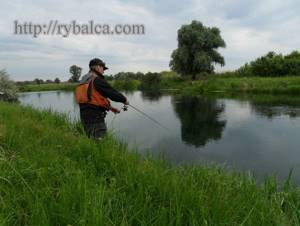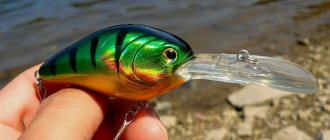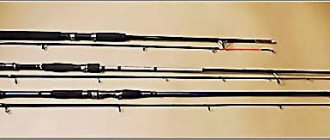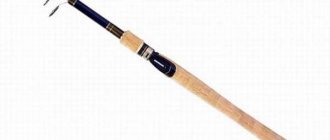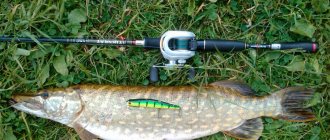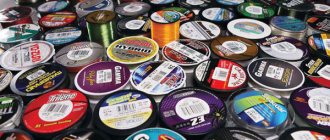Twitching is a special type of fishing that can give “life” to a spinning bait. The jerks created by the artificial fish actively lure all nearby predators towards themselves.
Correct and competent twitching is very difficult to achieve even for a professional with poor fishing rod equipment, and this primarily concerns the twitching reel.
Choosing a reel for twitching is a very important process in assembling a fishing rod. So which tackle is best to choose? Let's try to answer this question right now.
Twitching reel
Lekha Lu, I don’t have and never had a ryobi, unfortunately, I didn’t listen to the advice of experienced people and bought a shimanka first. I have no personal operating experience, but on my way, I have not yet met a fisherman who said anything bad. And this is from real life, when I meet people on the water and ask about gear. They write all sorts of things on the Internet.
In my homeland, in a small, not rich town, fishermen dream of buying Eksia. These are mostly mature people, 45 and older, the wages are not only small, but they also don’t allow you to go wild.
People are adults, they don’t know how to buy directly from Japan, and in stores the prices for Japs are HUGE. For example, an Ultegra from Japan will cost $150, but in our stores it costs $300
Among us, among this class of fishermen, the Eksia is considered a popular tractor, like a diesel Volkswagen of the 90s.
Local fishermen, last year, bothered me with their requests to bring them from Minsk. I don’t remember anymore, but I brought it from 10 o’clock. I live in Minsk, I have a friend here at work who sells all kinds of fishing equipment wholesale.
They made a deal out of me, it got to the point where strangers started calling me, like they gave me advice. I haven't put an end to this yet. That's how the shop closed.
This year, everyone I brought it to was very happy, no one said a bad word. I didn’t make money from anyone and was very worried that in case of a manufacturing defect, my brains would be composted. It's gone! I spat under the table 3 times)))
In general, the main thing is not the gear, but the principle of fishing. For me personally, in fact, it doesn’t really matter what gear you use to fish with. I always have a Chinese spinning rod lying around in my car, with a Chinese reel, with a total cost of $50. Some kind of fishing line, in the glove compartment there is a small box with baits.
Sometimes there is no time for long preparations, etc., I use this kit. I can dip it in the rain and in the river, and live on the sand. Completely relaxed! The fishing is just as good!
I think that the most important thing in a taxi is comfort. And for me, this is, first of all, quick and easy getting ready, comfortable old clothes, dry feet and warm, a full stomach, a bottle of water in my backpack, a pack of cigarettes.
And when my friends invite me to go on a serious fishing trip, like with a boat, a motor, or tents, it’s not the same at all. While you are carrying all these things, while you are laying them out on the shore, while you are assembling the boat, half a day will pass. As soon as we started fishing, we already wanted to eat, and when we finished eating, it was already getting dark. And tomorrow, it begins, one wants to go there, the other doesn’t want to go there. And by lunchtime, you start scratching your turnips like it’s time to go home.
I like it fast, without unnecessary things, alone! Wow, that's fishing!
But the real thrill is the trout forest river-stream, windbreaks, snags, bushes. For the whole weekend, with an overnight stay in the forest! I recommend!
Tackle - don't give a shit about it, buy what's easy for you to get your hands on!
The best models of spinning rods for twitching
There are many models of twitching spinning rods, and in the light of the above information, it becomes clear that you should not trust any lists of supposedly the best. All these top 10 and ratings of the best spinning rods for twitching are subjective fiction. Each spinning rod is good or bad for some specific conditions. Naturally, there is also useless junk that is not worth taking at all.
In the budget segment, it is quite possible to find a decent rod for specific fishing conditions, both a twitching stake and a universal stick. You need to choose carefully, dig up information on each model point-by-point, and not trust incomprehensible tops and ratings. Therefore, we will not distribute seats - there is no pedestal. Let's look at the models of fishing rods that are well-known and popular. And which one to choose is a matter of personal in-depth study and selection specifically based on models.
Budget models
There will be no specific review of spinning rods by model - this is impossible, since each rod deserves close attention and a separate article. They all differ in some way, not just in test and length. Nowadays it’s not difficult to find a normal budget twitching spinning rod, or in the middle range – and it will work to its maximum. It’s not for nothing that, for example, one of the leading Twitch specialists, S. Kutsay, has been fishing for years with one spinning rod that costs about 3,000 rubles. – and he’s happy with everything about it.
This is just a small list of models that, to start studying and searching, can be considered for working with wobblers, without assigning places. We search by name in a search engine, YouTube, watch and read forums, carefully weigh everything, and only then buy. Each model is available in various test versions and lengths, in a spinning or casting version, purely for twitch or universal. You need to go to the store for a specific spinning rod, and not listen to the salespeople.
- Favorite X1
- Norstream Standard
- Norstream Rooky
- Aiko Butch
- GAD Fair
- Gad Gancho
- Black Hole Hurricane
- Black Hole Bass Mania
- AIKO Oberon
- Maximus Manic
- Kosadaka Orange Twiching Point
- Kosadaka Intra Casting
Twitching rods from Aliexpress
Doyu-Jintai is no longer the same - these companies got significantly rich selling junk in the 90s, and now produce decent fishing rods. For 1500-3000 rubles from China you can order a spinning rod of the same quality as in a store for twice the price. Naturally, you can’t scoop up everything that’s cheapest from ali – there’s plenty of slag there. The same applies to twitch spinning rods.
More details - working spinning rods from aliexpress
According to the link, they are more generalists, but in terms of twitching, Jonko Booster and Vivid are beyond competition. Of course, there is also Tsurinoya Pro Flex. But Tsurinoya costs about 7000, and Jonko - 2000-2500, and at the same time they are indestructible hard workers.
Gradually, because of prices, the Chinese are beginning to bend the more famous manufacturers, producing models of a decent level at prices 2-3 times cheaper. See for yourself - a Chinese spinning rod for twitching with aliexpress Johncoo Booster. This, in principle, is now one of the best inexpensive budget spinning rods for wobblers in terms of price and quality on the market now (up to 3,000 rubles)
Jonko Booster comes with two tips. 7-28 perfectly twitches rudra, 5-15 for working with sheds and medium minnows. Price about 2000 rubles with coupons and sales. At the same time, the quality is the same as that of store-bought ones for 5 thousand.
This is not stupid advertising - watch the reviews on YouTube for yourself, who often comes to my site knows - I don’t recommend bullshit. This season I purposefully race the cheaper Sword station wagon from the same company on large wobblers for 1300 rubles - there were pikes for 7 kg with deflections for the boat, everything is fine with a stick. Delivery is free in a cardboard tube within a week from Moscow, if from China - about a month.
Jonko booster, official store: https://ali.pub/4dx03b

Jonko Vivid was originally designed for light jigs. However, due to the hard solid glue, this Chinese spinning rod for ultralight twitch works great with small wobblers. Also two tops. A working budget twitching spinning rod for light caliber, with a large tip, it pulls even some non-resistant 110 wobblers.
Jonko Vivid: https://ali.pub/4dx059
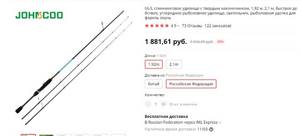
Elite spinning rods
What is an expensive spinning rod? This is an even more specific tool for a narrow range of fishing conditions and baits. Only a professional athlete can feel the nuances of St.Croix Legend Elite or SHIMANO Lesath SLECX21M. For the average hobbyist, there is no point in spending that kind of money on these Bentleys in the world of spinning rods, sometimes more than 20,000 rubles for a stick that is easy to break.
The only difference from the budget is the complex structure of the blank using high-modulus, and therefore more fragile graphites, in order to feel all the nuances of playing the bait in your hand. This is important in competitions when every perch is needed. Top American and Japanese spinning rods try to reduce weight, which is often done by thinning the walls. An amateur fisherman needs a reliable workhorse that will not let you down for years to come, and not an extravagant stick from which you need to blow off specks of dust.
Subscribe to the channel:
YouTube channel RYBAFAN
We are VKontakte
Types and technical characteristics
Reels for twitching fishing can be inertial, inertialess, multiplier. All three types of reels have different characteristics and are used for different types of twitching fishing.
Inertial coils for twitching:
An inertial twitching reel is the simplest type of reel. The reel choke is simple, it consists of a bearing, a line guide and a section for storing line. To ensure that the line in this reel does not intertwine during winding and release, the mechanism must be regularly cleaned of dirt.
The mechanism of the inertial reel does not stop rotation during casting, so the angler needs to perform the braking independently, which is not very convenient when twitching; one wrong movement and grooves form on the fishing line. Therefore, this type of reel is not recommended for beginner fishermen; they simply cannot cope with the twitching mechanism.
For professional fishermen, an inertial twitching reel is just a godsend. The reel accurately casts and hooks fish in a timely manner.
The advantages of inertial reels for twitching include the following parameters:
• Smooth running.
• The drum rotates easily and in a balanced manner.
• There is a regulator for feeding and releasing fishing line.
Spinning reels for twitching:
Inertia-free reels for twitch fishing are, first of all, easy to catch a trophy. The design of the spinning reel for twitching is made in such a way that when casting heavy and large baits, no loops are formed on the fishing line, and the casting itself is performed easily and with one hand. Inertia-free reels are equipped with a braking system, so the angler no longer needs to pay attention to what second to fix the line, the reel does everything itself, and also with an inertia-free reel you can adjust the trajectory of movement when casting the line, and the friction brake will not allow it to break during a bite.
The mechanism of spinning reels for twitching has a reverse rotation locking mechanism. The fishing line moves in one direction, due to which it does not get tangled during winding or during release.
Multiplier reels for twitching:
A multiplier reel for twitching is a more complex design; the mechanism operates on a gear winch. The spool of the multipliers is located transversely, which completely eliminates the overlapping of the fishing line.
The mechanism of the multiplier reel for twitching is highly sensitive. With such a reel it is easy to cast and control the bait. The inertial indicator of the multipliers is minimal, due to the design of the reduced drum. The reel has an automatic brake, which is controlled by a centrifugal gear.
During the fishing process, a multiplier reel allows the fisherman to regulate the braking process; this is the most significant advantage in twitching. The design also includes a hand brake; it works due to a rotating corkscrew mechanism, which is designed for sudden braking.
Multiplier reels for twitching are designed specifically for catching the most trophy fish and for working with heavy equipment; working with light-weight baits is impossible, since the technical design of the reel will make light fishing difficult.
Top 5 mid-segment reels for twitching
• Daiwa Lexa
: Baiting reel equipped with Daiwa Magforce friction brake. The compact body is made of aluminum. There is a mechanical anti-reverse. The comfortable Swept handle ensures good winding. Weight – 227 g, line capacity – 0.40 mm/110 m, maximum thrust – 5 kg, speed ratio – 7.1:1.
• Shimano Cardiff 200A
: multiplier aluminum reel. The internal mechanism consists of five ball bearings and one roller bearing. Weight is 230 g, spool capacity is 0.25 mm/250 m, speed ratio is 5.8:1.
• Okuma Cortez CZ-10CS
: powerful multiplier reel with anti-corrosion coating. Equipped with an oversized transmission mechanism and brake system, which ensure smooth running and uniform line tension. Weight – 499 g, forest capacity – 0.37 mm/420 m, speed ratio – 6.2:1.
• Salmo Vantage 9 20FD
: spinning reel with an additional spool included. The internal planetary mechanism consists of 10 bearings. There is a reverse stopper. Weight is 205 g, forest capacity is 0.20 mm/205 m, speed ratio is 5.1:1.
• Stinger Innova 2010
: powerless inertia with backlash-free Direct Drive mechanism. The Aerospin system ensures smooth and silent rotation of the mechanism. Successfully used for long casts. Weight is 278 g, spool capacity is 0.13 mm / 170 m, pulling load is 7 kg, speed ratio is 5.2:1.
Inertia coil

Even the design itself does not hide any complex mechanisms. In addition, this type of reel does not require maintenance compared to other types. Unfortunately, most of these fishing reels are not equipped with a braking mechanism. That is, when casting, the angler must use his fingers to brake the reel, otherwise, after the bait hits the water, the reel does not stop, since it rotates due to the inertial force that the weight of the bait gave it, that is, a lot of excess fishing line flies off it , in fishing slang it sounds like “beard”. Over time, manufacturers began to think about creating a braking mechanism; of course, this affected the cost and complexity of the reel mechanism. The operating principle is as follows: during the casting process, the fishing line presses on a special lever, which is directly connected to the braking mechanism, after which the rotation of the reel slows down. It is worth noting that there is a simpler mechanism for braking an inertial coil - a constant braking system. Before casting, such a system must be configured, that is, using a special lever, set the line feed speed.
Popular brands:
- Okuma
- Shimano
- Salmo
- Penn
- Spro
Conclusion: An inertial reel is not exactly a device with which you can easily catch a predator using twitching . Let's take a look at the following types of fishing reels.
What is coil gear ratio
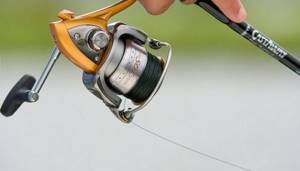
Let's first understand what a reel gear ratio is, what it is, and how this number can affect your fishing.
In modern mechanisms, torque in various components is provided by gear transmission. This is when two gears are interlocked, one of which transmits movement to the other. Thus, one of them is leading (it is turned by the engine or the fisherman through the handle), and the second is driven, since its movement is provided by the first. The rotation speed of both gears may be completely different. Thus, each gear can make its own number of revolutions in the same period of time. This is due to the different number of teeth, on which the rotation speed depends.
Let's look at a small example. If the drive gear contains 60 teeth, and the driven gear only thirty, then while the first one makes one revolution, the second one will spin as many as two times. To find out the gear ratio of such a coil, the value of the teeth of the driving gear is divided by the same number for the driven gear, that is, 60/3 = 2. Thus, the gear ratio in our example is two. So, knowing the meaning of this characteristic of the coil, what properties can we learn about in advance?
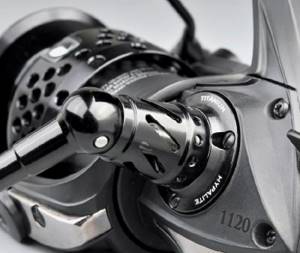
First of all, we note that the internal mechanism of the reel consists of many gears. They can be different in their properties. As soon as the fisherman begins to turn the handle, he starts the movement of the drive gear with a given number of teeth, and it already sets the rest of the mechanisms to work.
You may be interested in: Grayling
It is interesting to note that using the gear ratio it is possible to regulate the torque of the coil. This is achieved by changing the number of teeth in the gear.
So, the resulting rotation is transmitted by the main gear to one or more subsequent ones, which are in mesh with it. The last of these gears (or driven) rotates the line laying rotor. The manufacturer has calculated a strict number of revolutions that it will make in one full movement of the reel handle. To find out the gear ratio of the reel, it is necessary to correlate the number of rotations of the rotor with the revolutions of the handle.
Types of Fishing Reels
There are 3 types of fishing reels :
- Inertial
- Multiplier
- Inertialess
Which reel should I buy ? It all depends on its intended purpose. In combination with what gear you plan to use this or that type of reel. If we consider twitching tackle , then in principle any of these three types will do. The only difference will be how productive the work with the reel will be, how comfortable the fishing will be and which reel will be easiest for a novice angler to handle.
Features of twitching fishing for different types of fish
Perch fishing
With this type of fishing, slow retrieval should be combined with sharp jerks of the rod. If you observe the wobbler, we will note that it slowly moves forward with sharp turns to the left and right. The spinning rod moves continuously, jerking from top to bottom. If the perch does not have a zhor, then the fishing technique is somewhat different: you need to pause between jerks and it is at this time that the perch takes a bite.
You can fish well if you tweet in continuous jerks without pauses, either from top to bottom or from side to side.
Pike fishing by twitching
It is better to choose a place for pike fishing at the sources of rivers or in swampy lakes. A weak current, a grassy river bank or sun-warmed shallows of lakes are the favorite stopping places for predators. Wiring of the wobbler should begin at the edge of the water, a pond overgrown with grass. After casting the wobbler, do not rush to start retrieving, the pike is curious and will be interested in the splash of water. After waiting 5-7 seconds, slowly start playing with the wobbler. In the first seconds you can get a bite.
The technique of fishing for pike differs from fishing for perch in longer jerks with a small amplitude. If the pike is active, then the jerks should not be interrupted by pauses; otherwise, we alternate long jerks with short stops of a few seconds. In hot weather or when pike activity is low, pauses between jerks can be increased to 10 seconds. The more active the fish, the shorter the pauses should be.
Choosing a cord for twitching
The general requirements for an ideal twitching cord are quite standard - strength, small diameter with a high breaking load, smoothness, the ability to withstand friction against grass or algae for a long time without fluffing or losing reliability. Well, adding durability and low cost here, we get a standard set of requirements for cords (as in jigs). However, some of the requirements in twitching can be sacrificed.
For example, the highest smoothness
, and, consequently,
the maximum number of cores
in the overall weave of the cord is far from the main requirement. As you know, such cords are the most expensive, but in twitching and, in general, when fishing with wobblers, casting distance rarely plays a key role.
In many situations, excessive cord thickness
. If this is not fishing with small wobblers (up to about 10 g), then a thicker cord will be quite appropriate (it is unlikely to affect the bite, but will give additional confidence).
Many fishermen compensate for the lack of strength of an inexpensive cord by having an excess diameter. In other words, it is often justified to take a cord that is a little thicker, but cheaper.
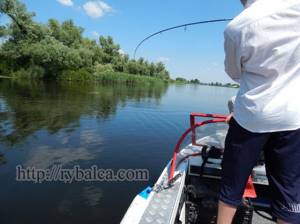
In principle, there are three categories of cords to consider for twitching. The main point of classification is the number of cores. This, in principle, will be equivalent to both the price of the cord and its quality. So:
Three-core
. These are the simplest and most inexpensive braids, but they are quite suitable for twitching. It is important here that it has a well-known name. The same thing, by the way, as the store selling these products.
It is believed that all Japanese cords coming to our market are of decent quality. With the exception of outright fakes, you can safely count on Japanese braids. Questions may apply to other countries, however, if the place of sale (store, outlet) is verified, then defects are very rare.
Four or five wire.
These are noticeably more advanced products, but also more expensive. Again, if it is not “China” at a bargain price or an obvious fake (this, fortunately, rarely happens), then not only a novice twitcher, but also everyone else can rely on such a cord.
Personally, I give preference to 4- and 5-core cords. Again, in order not to run into fakes or defects, it is better to buy cords in large and trusted fishing stores (not in grocery supermarkets and market stalls with nets and other things). As a rule, there is an official representative for all models in Ukraine, and he ensures that the product is of high quality.
Eight-core.
The highest quality products, their price ranges from $60 to $100. And if you can afford such a budget, these braids can be safely considered as the best cord for twitching. It is unlikely that it will fail, and there is no point in counterfeiting it - it is too expensive.
